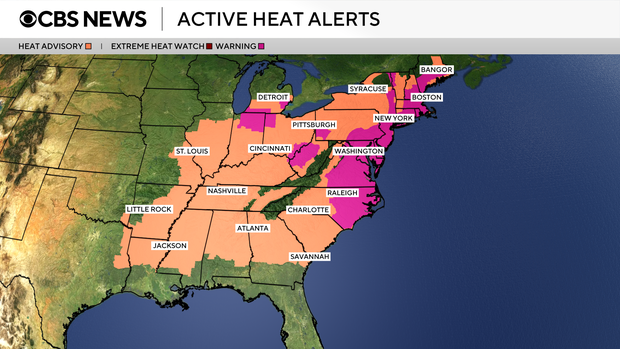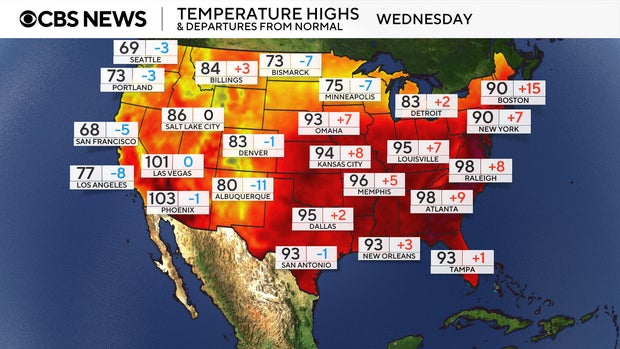Now Reading: Maps show heat wave forecast across much of U.S., with more record highs expected today. Here’s how long it will last.
-
01
Maps show heat wave forecast across much of U.S., with more record highs expected today. Here’s how long it will last.
Maps show heat wave forecast across much of U.S., with more record highs expected today. Here’s how long it will last.

A brutal heat wave has settled in across the eastern United States, with several days of record-high temperatures in the forecast this week.
Temperatures were expected to soar to 15-25 degrees above average on Tuesday, CBS News meteorologist Nikki Nolan said, and some areas will see heat index (“feels like”) readings of 110 degrees Fahrenheit.
In Philadelphia, the temperature hit 100 degrees on Tuesday for the first time since July 18, 2012. New York City’s Central Park had a heat index of 100 degrees in the early afternoon, according to the National Weather Service. John F. Kennedy Airport in New York, Boston and Baltimore also hit 100 degrees, as did Fryeburg, Maine, The Associated Press reported.
The worst heat is likely to peak for cities in the Northeast on Tuesday, according to the NWS.
“A large portion of the region will see high temperatures ranging between 98 and 101 degrees,” the agency said, with “numerous daily record maximum and minimum temperatures” expected through at least Wednesday.
“Light winds, sunny skies, and a lack of overnight cooling will pose a significant risk to those without adequate cooling and/or hydration,” the weather service warned.
A key measurement of the strength of the ridge of high pressure broke a record Monday, according to the NWS. It was the third-highest reading for any date, making for a “near historic” heat wave, private meteorologist Ryan Maue, a former chief scientist at the National Oceanic and Atmospheric Administration, told The Associated Press.
More than 160 million Americans are under the highest level extreme heat alerts. Including heat advisories, the total number affected rose to about 200 million. This marks one of the most expansive heat alert events ever, with major population centers from the Midwest to the Northeast under serious heat strain.
CBS News
Here’s what to know about the heat wave and how to stay safe.
Heat wave forecast maps
“Summer has taken its time arriving in the Northeast, but it’s coming in HOT,” the National Weather Service wrote in a social media post last week, warning of triple-digit heat index readings “with oppressive humidity.” The heat index is what the actual temperature feels like when it’s combined with relative humidity.
Heat indexes on Sunday hit 103 F in Chicago, 105 in Pittsburgh and around 104 in Columbus, Ohio. The heat index in Philadelphia topped out at 108 on Monday.
Meteorologists say it’s due to a heat dome — an area of high pressure in the upper atmosphere that traps heat and humidity — sitting over a large portion of the country. When a heat dome becomes stationary, the air within it can become extremely hot and stagnant, leading to dangerously high temperatures and poor air quality.
The first few heat waves of the season are particularly dangerous because the human body has yet to adjust to the seasonably warmer temperatures, experts say.
“You’re talking about some places that could be 40 degrees warmer than last week. So that’s a big deal,” NOAA meteorologist David Roth said.
These maps show daily forecast highs across the country and their departures from average temperatures.
CBS News
CBS News
How long will the heat wave last?
The heat shifted into the Midwest and Ohio Valley and then arrived in the Northeast and mid-Atlantic on Sunday, where it will linger through the first half of this week. The most extreme temperatures are expected to peak on Tuesday in many areas, but highs in the 90s continue through Wednesday.
Parts of the Northeast face a “High Risk” of extreme heat through the middle of this week, according to the National Weather Service.
“I cannot emphasize this enough: extreme heat can be deadly,” New York Gov. Kathy Hochul warned. “The best way to stay safe is stay indoors, with air conditioning. This is not the time to start training for the marathon.”
What constitutes a heat wave?
A heat wave is a period of unusually hot weather that lasts more than two days, according to the National Weather Service. It often, but not always, covers a wide area and can expose a large number of people to hazardous heat, which can be extremely dangerous for vulnerable people, including children and the elderly.
Warmer overnight low temperatures can make a heat wave especially dangerous, since they mean the body doesn’t get as much of a chance to cool down.
“Your body needs a reprieve,” Ashley Ward, director of the Heat Policy Innovation Hub at Duke University, told The Associated Press. “You don’t get that overnight, we start the next day at a deficit.”
When overnight temperatures stay above about 75 degrees Fahrenheit, she said, “You start to see some pretty extraordinary outcomes with respect to heat illness and heat stroke, and even mortality.”
Climate change is making extreme temperatures and heat waves more frequent and longer-lasting, with the number of days above 95 degrees expected to increase across the U.S.
How to stay safe during a heat wave
Heat is the leading cause of weather-related deaths, and heat-related illnesses increase significantly during extreme heat and high humidity events.
The simplest way to way to avoid heat-related illnesses is to stay out of the sun and avoid extended time outdoors in extreme temperatures, experts say.
If strenuous outdoor activities are unavoidable, you should dress for the heat and wear lightweight, loose-fitting and light-colored clothing, the National Weather Service recommended. You should also stay hydrated by drinking plenty of water, even if you’re not thirsty.
It’s also important to be aware of any symptoms of overheating, which include muscle cramps, unusually heavy sweating, shortness of breath, dizziness, headaches, weakness or nausea, according to the Centers for Disease Control and Prevention. If you experience these symptoms, one major sign to seek care is if the symptoms don’t improve after getting into a cooler environment or hydrating, experts say.
Tracy J. Wholf,
Nikki Nolan and
contributed to this report.





















































